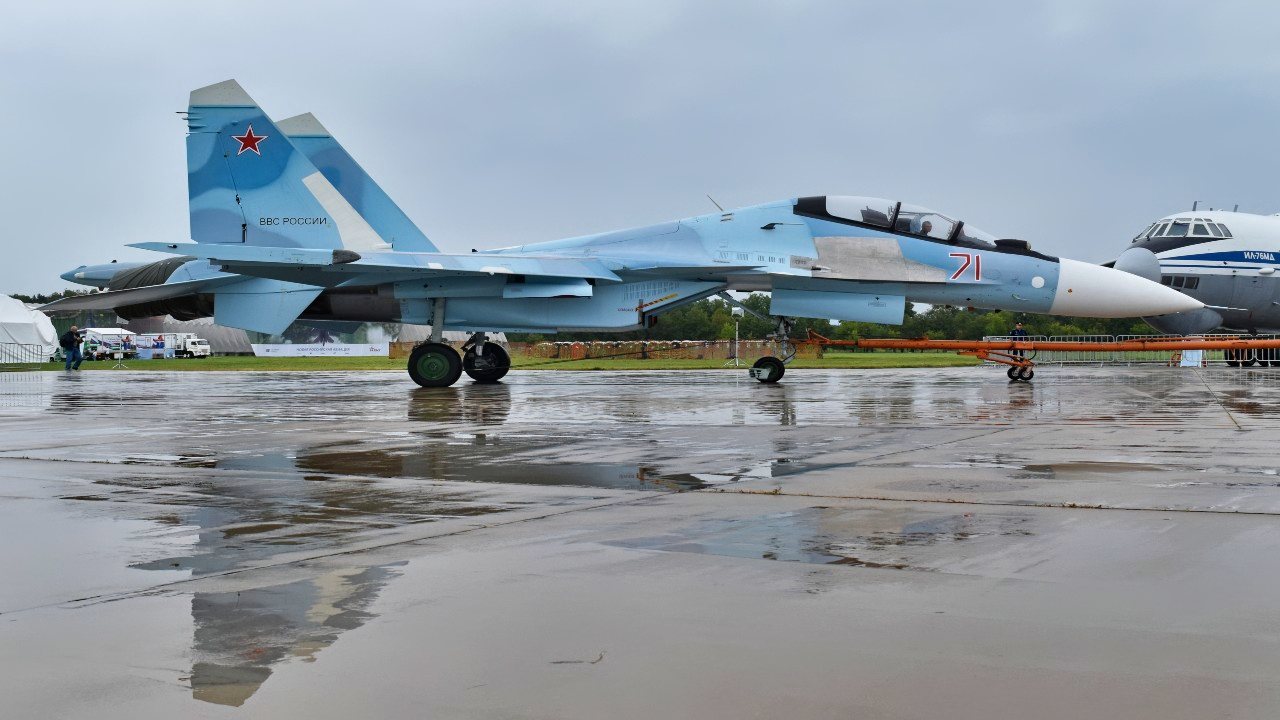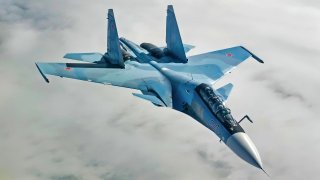Russia Finds New Role for Its Deadly Su-30SM Fighter Aircraft
It was recently reported that the Russian Aerospace Force is now employing its Su-30SM fighter aircraft to counter unmanned seacraft in the Black Sea.
It was recently reported that the Russian Aerospace Force is now employing its Su-30SM fighter aircraft to counter unmanned seacraft in the Black Sea. The Kremlin has increasingly touted the capabilities of the fighter. It was a year ago that the Russian state-owned United Aircraft Corporation (UAC) delivered the latest batch of the fighter jets.
The Sukhoi Su-30SM (NATO reporting name "Flanker-H") is an upgraded variant of the twin-engine, two-seat supermaneuverable fighter aircraft that was initially developed in the late Soviet era as a multirole fighter for all-weather, air-to-air and air-to-surface deep interdiction missions.
The SM (Serial Modernized) model is a deeply modernized variant of its four-decade-old predecessor, which itself is a heavy, thrust-vectoring, long-range, and multirole advanced variant of the Sukhoi Su-27 (NATO reporting name "Flanker"). That aircraft made its maiden flight in 1986, while production began in 1992.
It was renamed the Su-30 only in 1996.
As previously reported, the aircraft was initially developed in the Soviet Union by manufacturer Sukhoi Aviation Corporation, and today the twin-engine supermaneuverable airframe remains a staple in Russia's aerial strategy.
Similar to most of Russia's more modern jets, the Su-30 is essentially a descendant of the Sukhoi-27 airframe – which was designed specifically to counter American-made fourth-generation fighters the Grumman F-14 Tomcat and the McDonnell Douglas F-15 Eagle.
Thanks to the vast improvements, the Su-30SM has been generally considered a fourth-plus-plus (4++) generation fighter jet that has upgraded radar, radio communications systems, and jamming pods; improved friend-or-foe identification systems; and other enhanced aircraft systems. The airframe of the Su-30SM is made of titanium and high-strength aluminum alloys.
The Su-30SM is also equipped with the N011M Bars radar with a maximum detection range of 400 km, and a search range of 200 km using a phased array antenna, frontal horizontal fins, and steerable thrusters for super maneuverability as well as wide-angle HUD. The Russian fighter can be employed in an air supremacy role and for the targeting of adversaries on the ground using a wide range of weapons including air-to-air, air-to-surface, and guided and unguided bombs with total weapons weight up to 8,000 kg.
It is also equipped with the one barrel, 30 mm GSh-30-1 autocannon.

For electronic warfare purposes, two SAP-518 jamming pods can be fitted on the wing tips. The SAP-518 is designed to protect the aircraft from various air-to-air and surface-to-air missiles by creating false targets, jamming missile guidance, enemy aircraft radars, or ground and seaborne air defense.
Su-30: Further Improvements
In August 2019, the Russian Defence Ministry first signed a contract for an undisclosed number of modernized Su-30SM2, which was then referred to as the Su-30SM1. First deliveries to the Russian Aerospace Forces had been scheduled for late 2020 with serial deliveries to commence in 2021.
That, of course, didn't seem to happen.
Complete specs of the Su-30SM2 haven't been released, but it was reported that the aircraft would receive the N035 Irbis radar and AL-41F1S engines of the Su-35S, as an effort to standardize and reduce operational costs of the two variants. According to a report from state media outlet Tass, the AL-41F-1S engine allows the fighter to develop supersonic speed without an afterburner thrust. The experimental AL-41F-1 turbojet engine was reported to perform the function of the first-stage powerplant for the Su-57 (PAK FA) fifth-generation fighter.
In addition, the aircraft's armament was also enhanced to include the new KAB-250 aerial bombs and Kh-59MK2 stealth cruise missiles.
The Su-30SM is being upgraded by the Irkut Aircraft Corporation and the Sukhoi Design Bureau.
The Kremlin had previously planned to modernize all Russia's Su-30SMs to the SM2 standard – but given the state of the Russian military, it is unclear when that could occur. Moscow currently operates more than 100 of the aircraft, which are spread across its air force and naval aviation branches – and it is one of Russia's most prolific modernized fighter aircraft.
Targeting Ukraine Sea Drones
According to recent reports on social media, the Su-30SM has been successfully employed to target Kyiv's sea-based drones. However, critics have contended this would be a significant overkill – and a costly method to counter the drones.
Of course, given the damage those drones can do – and more importantly have done – to Russian warships in Sevastopol and other ports, perhaps the Kremlin isn't being overcautious. The Su-30SM seems to have a near-perfect rate when countering drones.
Video of the Su-30SM in such an operation has been shared on X, the social media platform formally known as Twitter.
Exported Aircraft
In addition to service with the Kremlin's forces, the Su-30MK series of fighters have been exported around the globe. The Armenian Air Force, Indian Air Force, and China's People's Liberation Army Air Force (PLAAF) along with several other nations possess advanced derivatives of the platform.
In September, Myanmar also received the first shipment of two of a planned six Su-30SME fighter jets. The U.S. has condemned the sending of the aircraft to the Myanmar government and suggested it could be a catastrophe that will likely fuel the ongoing conflict in the Asian nation.
Author Experience and Expertise
Peter Suciu is a Michigan-based writer. He has contributed to more than four dozen magazines, newspapers, and websites with over 3,200 published pieces over a twenty-year career in journalism. He regularly writes about military hardware, firearms history, cybersecurity, politics, and international affairs. Peter is also a Contributing Writer for Forbes and Clearance Jobs. You can follow him on Twitter: @PeterSuciu.
All images are Creative Commons.


